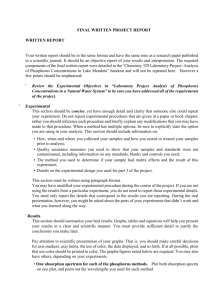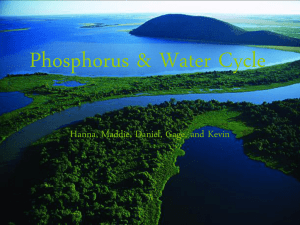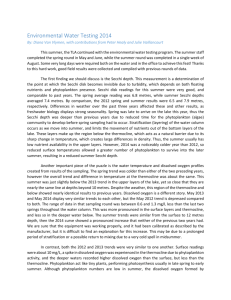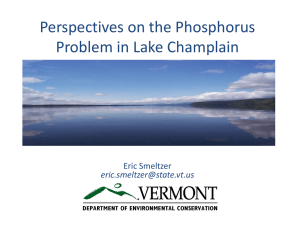doc
advertisement
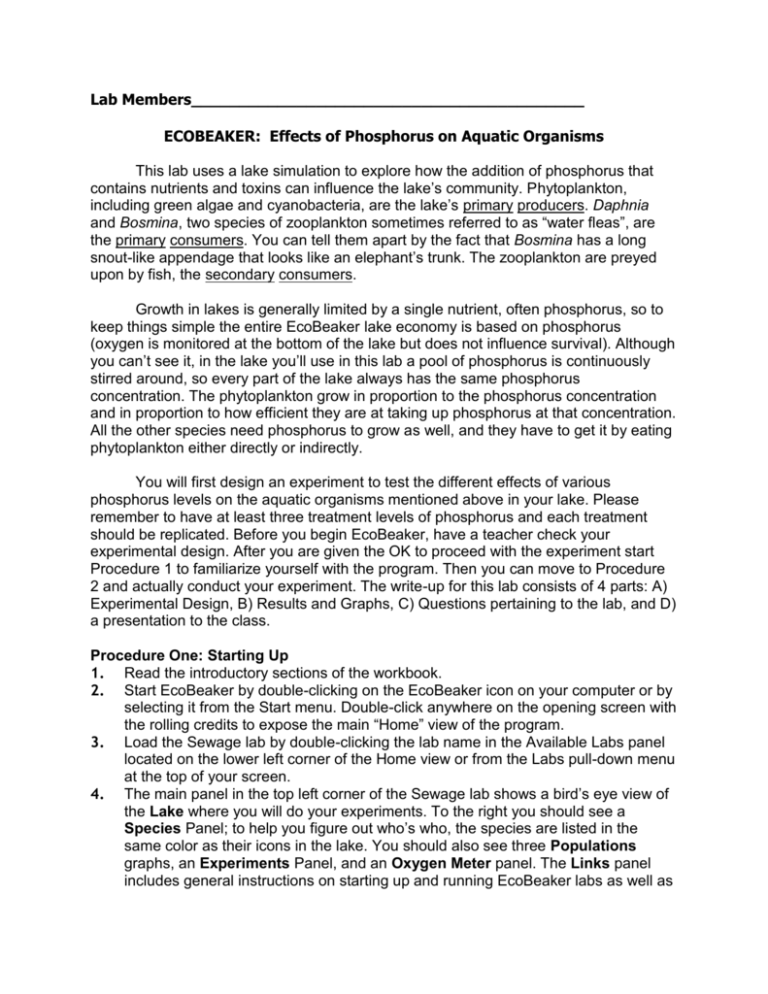
Lab Members_________________________________________ ECOBEAKER: Effects of Phosphorus on Aquatic Organisms This lab uses a lake simulation to explore how the addition of phosphorus that contains nutrients and toxins can influence the lake’s community. Phytoplankton, including green algae and cyanobacteria, are the lake’s primary producers. Daphnia and Bosmina, two species of zooplankton sometimes referred to as “water fleas”, are the primary consumers. You can tell them apart by the fact that Bosmina has a long snout-like appendage that looks like an elephant’s trunk. The zooplankton are preyed upon by fish, the secondary consumers. Growth in lakes is generally limited by a single nutrient, often phosphorus, so to keep things simple the entire EcoBeaker lake economy is based on phosphorus (oxygen is monitored at the bottom of the lake but does not influence survival). Although you can’t see it, in the lake you’ll use in this lab a pool of phosphorus is continuously stirred around, so every part of the lake always has the same phosphorus concentration. The phytoplankton grow in proportion to the phosphorus concentration and in proportion to how efficient they are at taking up phosphorus at that concentration. All the other species need phosphorus to grow as well, and they have to get it by eating phytoplankton either directly or indirectly. You will first design an experiment to test the different effects of various phosphorus levels on the aquatic organisms mentioned above in your lake. Please remember to have at least three treatment levels of phosphorus and each treatment should be replicated. Before you begin EcoBeaker, have a teacher check your experimental design. After you are given the OK to proceed with the experiment start Procedure 1 to familiarize yourself with the program. Then you can move to Procedure 2 and actually conduct your experiment. The write-up for this lab consists of 4 parts: A) Experimental Design, B) Results and Graphs, C) Questions pertaining to the lab, and D) a presentation to the class. Procedure One: Starting Up 1. Read the introductory sections of the workbook. 2. Start EcoBeaker by double-clicking on the EcoBeaker icon on your computer or by selecting it from the Start menu. Double-click anywhere on the opening screen with the rolling credits to expose the main “Home” view of the program. 3. Load the Sewage lab by double-clicking the lab name in the Available Labs panel located on the lower left corner of the Home view or from the Labs pull-down menu at the top of your screen. 4. The main panel in the top left corner of the Sewage lab shows a bird’s eye view of the Lake where you will do your experiments. To the right you should see a Species Panel; to help you figure out who’s who, the species are listed in the same color as their icons in the lake. You should also see three Populations graphs, an Experiments Panel, and an Oxygen Meter panel. The Links panel includes general instructions on starting up and running EcoBeaker labs as well as 5. 6. links to additional background information pertinent to the lab. Last but not least, the Control Panel, which includes the buttons that start and stop the simulation, can be found at the bottom of the screen on the left. Start running the model by clicking on the GO button (green arrow) in the Control Panel. In the lake you should see two phytoplankton species - green algae (light green circles) and cyanobacteria, which are also known as blue-green algae (darker green circles). You should also see two zooplankton species, Daphnia and Bosmina. The Bosmina are the ones with the long snout-like appendages. You should also be able to find some fish. Watch how the populations go up and down over time. Note that you can use the slider bars on the side of the Lake panel to see more of the lake. Familiarize yourself with the population graphs and the oxygen meter. Practice starting and stopping the model with the GO (green arrow) and STOP (red stop sign) buttons. Because the lake is pretty deep, at any one time you can’t see everything that is there. If you use the STEP button (the green triangle to the right of the GO button), you can advance one time-step which causes the creatures to move a little and sometimes expose another creature below. If you want the model to run slower or faster you can adjust the speed with the Speed-control slider to the right of the Control Panel. Finally, in this laboratory you will need to keep track of time so be sure you can find the Time-tracker to the right of the Speed-control slider. Procedure Two: Effects of Phosphorus on Aquatic Organisms As you recall from class, phosphorus can have major impacts on aquatic systems. Now it is time to conduct the experiment you designed. 1. 2. 3. 4. 5. 6. 7. 8. If you have not already hit the RESET button, do so now. Hit the GO button and allow the model to run for one year (52 weeks). When you have reached 52 weeks (plus or minus a few weeks is OK) hit the STOP button. Record the current time-step (it should be approximately 52 weeks), the phosphorus level and the approximate number of phytoplankton, zooplankton, and fish (from the graphs) and record it on the table below. Once you have recorded the above data, hit the RESET button. Remember to repeat each phosphorus level the number of times stated in your experimental design. Once you have finished a phosphorus level, click on the "Phosphorus input" item in the Experiments panel. This will allow you to change the level. Click on the GO button. Again, Record the current time-step (it should be approximately 52 weeks), the phosphorus level and the approximate number of phytoplankton, zooplankton, and fish (from the graph) and record it on the table below. Continue this procedure until you are finished with your experiment. Worksheet A. Experimental Design Question: Hypothesis: Methods (include treatments and replicates): B) Results and Graphs Results: Phosphorus Level Replicate Time Step Phytoplankton Zooplankton Table of means: Phosphorus Level Phytoplankton Zooplankton Fish Fish Graphs: Make three bar graphs showing the effect of phosphorus on 1) phytoplankton, 2) zooplankton, and 3) fish. Your aquatic organism should be on the y-axis and phosphorus level on the x-axis, and remember to graph using means. C. Follow-up Questions 1. What effect did phosphorus have on the following organisms and why do you think this happened? a) phytoplankton b) zooplankton c) fish 2. How do you think high phosphorus will impact the “attractiveness” of the lake? 3. Do you think phosphorus is always bad? What if there were no phosphorus additions into a lake? 4. Choose a local industry or company and evaluate how it may contribute phosphorus to the lake. How could this company decrease the amount of phosphorus going into the lake? Is this company a point or non-point source of pollution to the lake? How would this impact the industry or business itself? How would this affect your lake? D. Presentation Create a short presentation for the class describing your question, hypothesis, and experimental design. Also discuss a summary of your results and how you think phosphorus affects aquatic organisms and why (question 1). Finish your presentation with a description of how the company you researched could decrease phosphorus inputs onto the lake. Also describe how this would affect your company and the lake (question 4).

